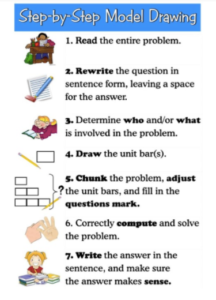
TCS Atlanta Math Specialist Tom Pittard (shown here with his son, TCS third grader Thomas) explains how models are used in Singapore Math.

Problem solving skills are at the center of Singapore Math teaching. Along with number sense and place value, teaching students to draw models of real world situations is essential to developing critical thinking. Beginning in kindergarten our students use objects and visuals to compare quantities and talk about changes in amounts. As they age, they are increasingly encouraged to visualize these objects, amounts and changes with ever increasing levels of abstraction. Starting in the second grade, students are taught a specific method of drawing models to illustrate the part-to-whole relationship of sets of numbers. This excerpt from the “Math In Focus Teacher Guide” might just explain it best:
“The importance of bar models to the Singapore approach cannot be over-emphasized. This model is used consistently from Grade 2 up, and becomes a bedrock for proportional reasoning and algebraic thinking in later grades. It works as well for part-whole relationships and comparisons in Grade 2 as it does for fraction operations and proportions in Grade 5 and is a major factor in the Singapore success story.”
Before using bar models, children use pictures and blocks through a one-to-one correspondence; three butterflies represent three butterflies or seven blocks might represent seven people. But because it is not feasible, or efficient, to represent larger numbers in this way, bar models can provide a useful pictorial representation of sets. One long, rectangular bar might represent 350 toys that need to be divided among seven trucks. Students practice labeling their bar model with words as well as numbers so they can turn the situation into a meaningful visual that helps to make sense of what operation to perform in order to answer a question.
This video of Dr. Yeap Ban Haar, an international expert on math instruction in the Singapore method, offers another great explanation of model drawing.
Even more important than quick number fact recall, is the accurately identifying the problem that needs solving or question to be answered. We teach our students to use a seven-step method of problem solving that breaks the process into manageable tasks that further help to make sense of a situation. These steps are:

You can see this system in action on the Haiku Singapore Math Resources page. I’m able to answer what initially seems like a pretty challenging question, by making it into a bar model visual.

This is an example of one way of answering this question. Another key feature of model drawing is that students are taught specific ways of working their way through the process. Different approaches to solving problems are not only welcomed but encouraged, and for some students, may even be required. When Greg Tang visited early in the year, he often encouraged us to “get clever” in our solutions (as well as our handling of numbers). The Haiku Singapore Math Resources page also has a video example of two ways to answer the same question.
Bar models help our students make sense of situations, identify the work that needs to be done and communicates his/her thinking about how he/she answered a given question. Watch how your children’s thinking becomes more clear as they continue to grow this skill.
Happy problem solving!
Tom









